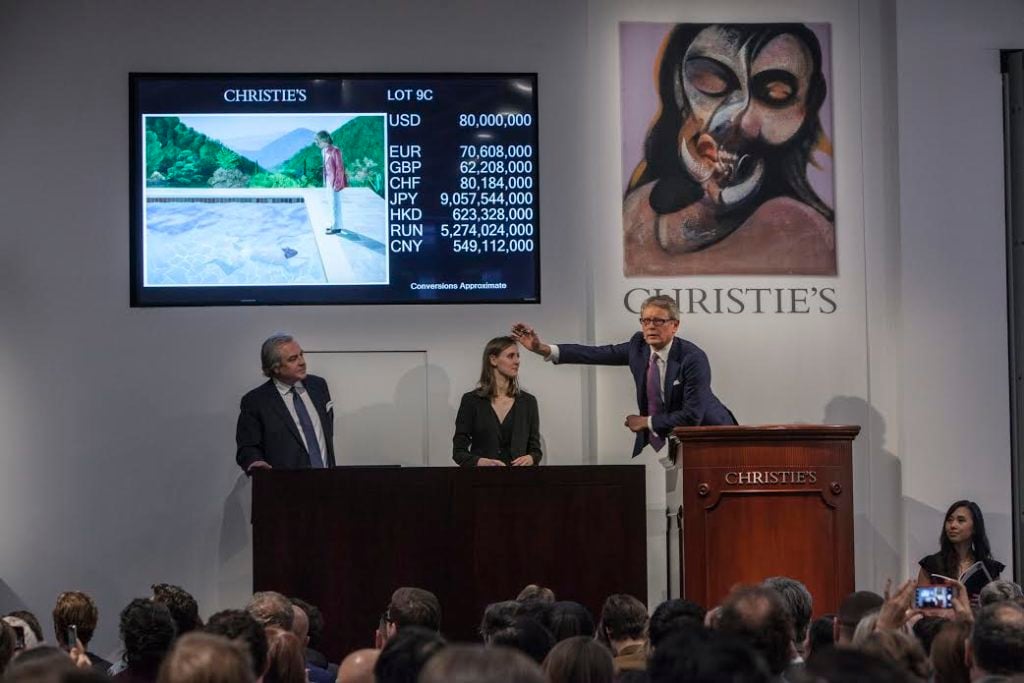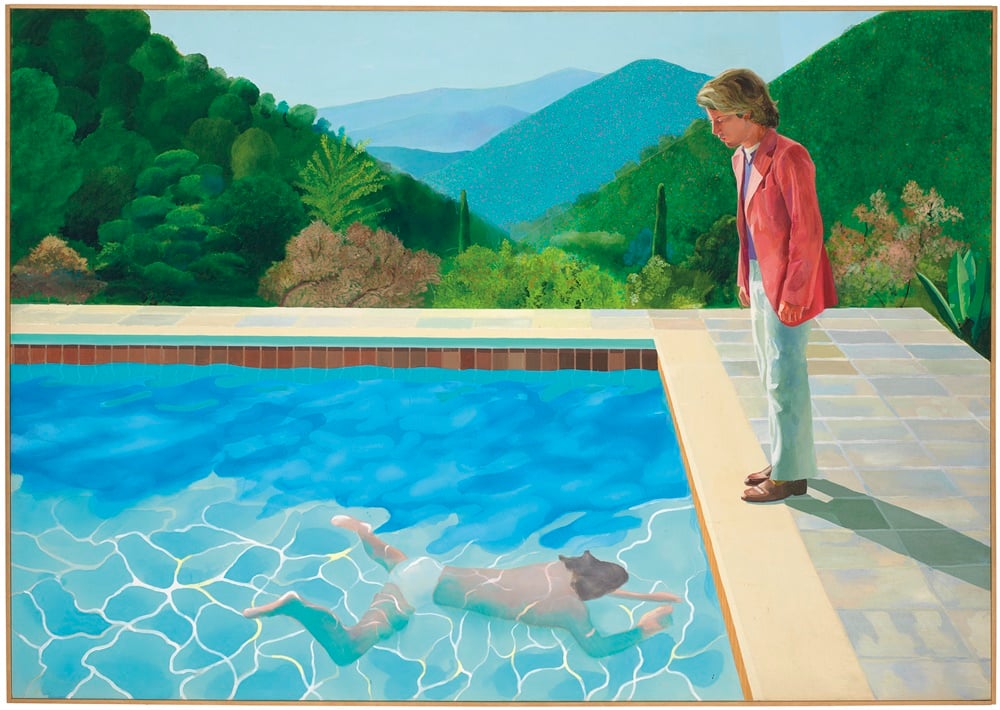Auctions
With a Historic Splash, David Hockney Becomes the World’s Priciest Living Artist in Christie’s $358 Million Postwar Sale
The work by the British artist topples Koons's Balloon Dog to become the most expensive work by a living artist.

The work by the British artist topples Koons's Balloon Dog to become the most expensive work by a living artist.

Just as Christie’s has been predicting—one might even say, hyping—81-year-old British artist David Hockney became the most expensive living painter tonight when Portrait of an Artist (Pool with Two Figures) (1972) sold for $90.3 million at the postwar and contemporary art auction in Rockefeller Center. All told, the sale realized a total of $357.6 million, compared with a revised pre-sale estimate of $323 million to $421.5 million.
The record-making Hockney’s unpublished pre-sale estimate had been $70 million to $100 million, though much of the pre-sale chatter guessed $80 million as the likely level.
Generating almost as much buzz as the sky-high asking price was the fact that the Hockney painting went to the block without any type of guarantee—almost unheard of in this day and age, when consignors know how to play the big auction houses off against one another.
More stunning still was the fact that the work did not have a reserve—an undisclosed minimum price at which the buyer or auction house agrees to let it sell. Auctioneer Jussi Pylkkanen playfully addressed the point and drew laughs from the audience when he quipped, “And everyone wants to know where I can start it.”
He opened bidding for the Hockney at $18 million. It was immediately met with a volley of bids—both from the room and on the telephones.

David Hockney, Portrait of an Artist (Pool with Two Figures) (1972). Courtesy of Christie’s Images Ltd.
It shot up in $2 million and $3 increments and was in the mid $60-millons within about 60 seconds. Bidding eventually came down to a two-way war between Christie’s chairman Marc Porter and another Christie’s specialist bidding for a client. They duked it out from about $70 million on, mostly in $500 thousand increments.
Portrait of an Artist was finally hammered down to Porter’s bidder for $80 million. The whole process lasted 9 long minutes.
The final result made Hockney the top selling living artist, eclipsing the previous record of $58.4 million set for a giant Jeff Koons Balloon Dog. It also more than tripled the British artist’s current record of $28.4 million set in May.
Hockney’s market has been on a tear of late. The consignor, believed to be British billionaire Joe Lewis, clearly bet big on this work, which he had owned for more than 25 years, having acquired it from entertainment mogul David Geffen in 1993. Though no one knows what kind of financial arrangement he had with Christie’s, the fact that he carried the risk—to the degree that there actually was any—made him the biggest winner of tonight’s sale, hands down.
The sale was strong, if not spectacular, throughout the course of two hours, after a winter storm delayed the proceedings by about 20 minutes from the expected 7 p.m. start time. (A star lot by Kerry James Marshall was recently withdrawn after the artist criticized the Chicago Public Library’s decision to sell it. And shortly before the sale started tonight, two more lots were announced as withdrawn, including a Willem de Kooning painting from 1947.)
Bidding on most of the top lots seemed measured rather than frothy, as if buyers were setting the tone. As a result, most of the top works landed squarely near their pre-sale estimate.
It seemed buyers knew what they wanted, and chased objects accordingly. Thus, while Hockney was the man of the night, another Hockney swimming pool sold for $7.3 million on a $6-8 million estimate, hardly anything to write home about in these climes.
Untitled (Rust, blocks on plum) (1962) by Mark Rothko, which carried a financial guarantee and hailed from the collection of Francois and Susan de Menil, of the storied Houston collecting family, was estimated at $35 million to $45 million.
Pylkkanen opened bidding at $24 million. After a few bids it was quickly hammered down to a Christie’s specialist for $32 million (or $35.7 million with premium).
Another closely watched (and guaranteed) lot was Francis Bacon’s Study of Henrietta Moraes Laughing (1969), which is the first work to come to auction from the estate of late publishing magnate S.I. Newhouse. It had an estimate of $14 million to $18 million, and went slightly above the high end before being hammered down for $19 million to a buyer bidding through Loïc Gouzer, Christie’s co-chairman for postwar and contemporary art. The final price with premium was $21.7 million.
Heated bidding came only in spikes—though the night’s sale started with a bang when a work by Philip Guston sparked a race to the top. It was the property of fabled collectors Harry “Hunk” and Margaret “Moo” Anderson, who had donated the bulk of their work to Stanford University a few years ago.
Window (1969-70), a graphite on paper showing one of Guston’s signature hooded figures pointing and smoking a cigar, was estimated at $300,000 to $500,000. Bidding opened at $140,000 but it quickly soared north of the high estimate and was hammered down for $2.6 million to a buyer in the room for $3.1 million with premium.
Similarly, Alexander Calder’s white hanging mobile 21 Feuilles Blanches (1953), owned by the same Swiss collector for over 60 years, also drew a volley of interest after it was opened at $3.8 million. It drew bids from dealers seated in the room including Dominique Levy and the Nahmad family before reaching a hammer price of $15.6 million, won by Gouzer’s phone bidder. The final price with premium was just shy of $18 million—$17,975,000, to be exact. (Another Calder with an identical estimate sold for $9.3 million.)
Christopher Wool’s Untitled (1990), spelling out RUN DOG RUN in his signature block letters, sold for $15.2 million compared with an estimate of $14 million to $18 million.
Jean Michel Basquiat’s Discography Two (1983) estimated at $20 to 30 million, was perhaps not as eye-catching as some of the artist’s more colorful or graffiti-adorned paintings. It sold for $20.9 million after being hammered down for an under-estimate $19 million to Christie’s co-chairman of postwar and contemporary Alex Rotter.
Meanwhile, Richard Diebenkorn’s Ocean Park #137 (1985), a prized work, had the added cachet of being owned for four decades by the late actress Mary Tyler Moore, who had acquired it from LA Louver in 1988. As Rotter and Gouzer, standing side by side at the telephone podium, duked it out in $100,000 increments for the Diebenkorn, Pylkkanen joked that it was the “clash of the titans.”
He had opened bidding at $15 million, compared with a low estimate of $18 million. The work sold for $19.2 million. The final price with premium of $22.6 million brushed up against the current auction record for Diebenkorn of $23.9 million, set earlier this year at Christie’s New York when a work from the same series, Ocean Park #126 (1984), beat its pre-sale estimate of $16 million to $20 million.
Among the auction records set tonight was a new high for Sam Gilliam, who, at age 84 is finally getting a well-deserved spotlight. Lady Day II (1971) sold for $2.2 million, roughly $1 million above the previous record of $1.2 million set this past June at Sotheby’s London for Forth (1967).
Records were also set for two other artists: Robert Colescott, whose Cultural Exchange, sold for $912,500, nearly tripling its estimate; and Pierre Soulages, whose Peinture 186 x 143 cm, 23 décembre 1959, realized $10.6 million.
Among buyers spotted in the room, dealer Larry Gagosian, who was seated next to his new hire Andrew Fabricant, a longtime director of the Richard Gray gallery, scooped up two works by Warhol towards the end of the sale. After nabbing Warhol’s graphite and colored pencil on paper Do It Yourself (Violin) (1962) for $5.7 million, he then proceeded to bid on Tunafish Disaster (1963), a silkscreen painting from the artist’s famous “Disaster” series that included car crashes and other macabre themes.
Gagosian was poised to win the work with a $4.7 million hammer bid when Pylkkanen, seemingly taking his time bringing down the hammer, managed to coax one more $100,000 from Rotter’s bidder, who seconds before, seemed out of the running. This prompted an audible “Come on!” from the mega-dealer, who had donned a cap and appeared ready to leave the auction room—and did so promptly after placing the final, winning bid.
The final price with premium was $5.9 million.
As always, repeat auction sales provide a measure of market appreciation, or lack thereof. Several lots offered in tonight’s sale had appeared at auction within the past decade or so. Here’s how they performed: